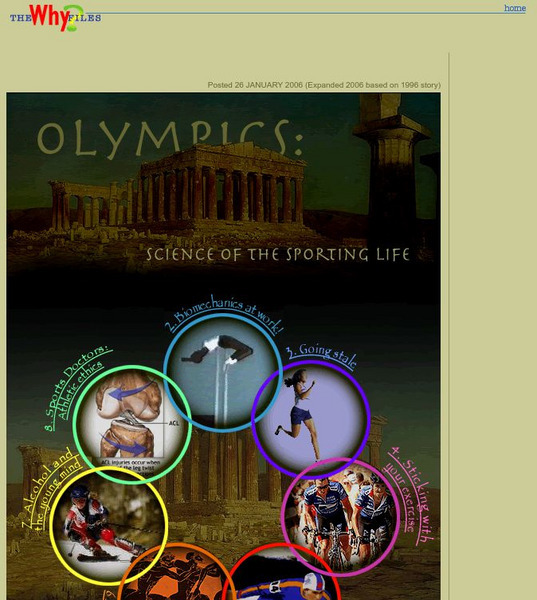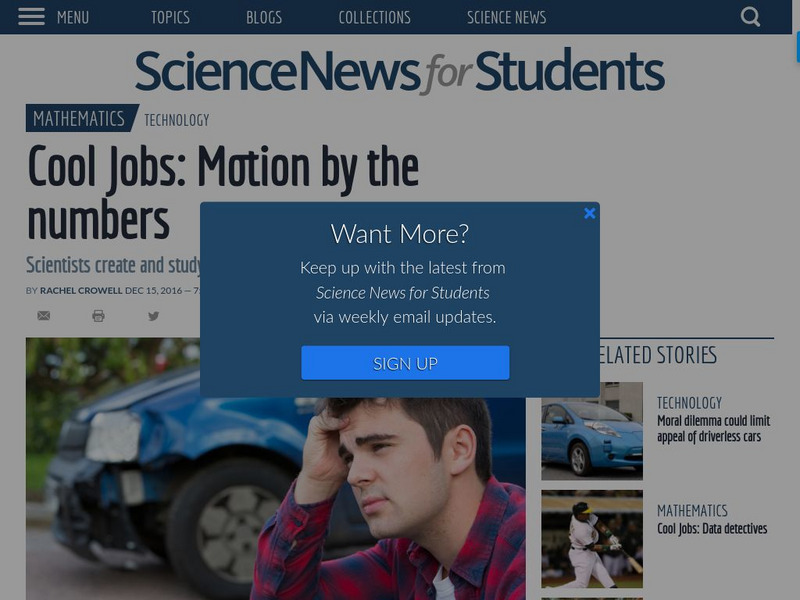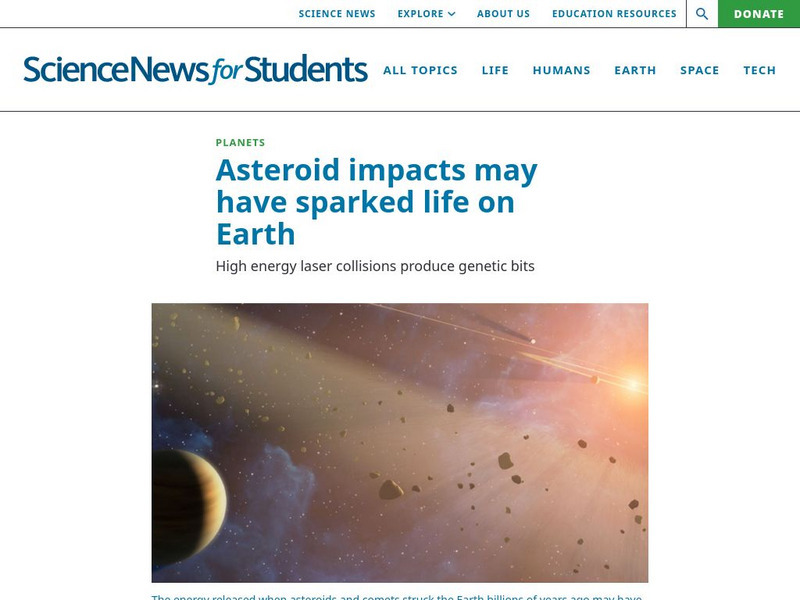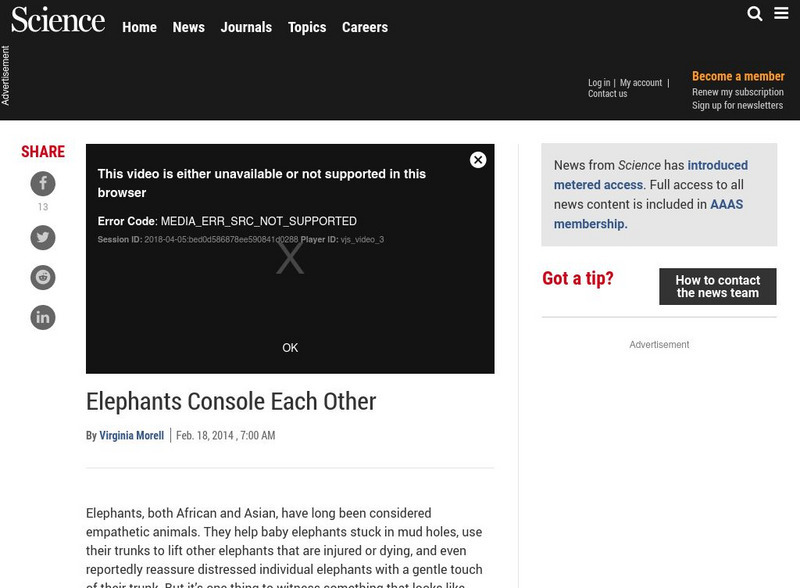NASA
Keeping Nine Eyes on the Weather
Take a look at climate change from another angle. Readers learn about the MISR instrument on the Terra satellite and how it studies Earth. Pupils experience how the multiple cameras give scientists multiple views so they can better study...
NASA
Taking Apart the Light
Break down light into spectra. Scholars learn how atoms emit and absorb photons and come to understand how this process allows scientists to identify different atoms based on either absorption lines or emission lines. Learners then...
Untamed Science
Untamed Science: Ecology: The Study of Interactions
Learn about how ecology is simply the study of how and why organisms interact with their environments.
The Franklin Institute
Franklin Institute: The Case Files: History of Cosmic Inquiry
A history of the science of cosmology, the study of the universe, and the scientists who did pioneering work in this field in the twentieth century.
University of Wisconsin
The Why Files: Olympics: Science of the Sporting Life
When the Winter Olympics begin we can study the science of sports: biomechanics, figure skating, high jumping, mental preparation, alcohol and athletes, sports doctors, staleness, and training in the ancient Olympics.
Khan Academy
Khan Academy: Biology: Chemistry of Life: Matter, Elements, and Atoms
Did you know matter is made up of atoms? In this article learn about the smallest unit of matter called the atom.
Society for Science and the Public
Science News for Students: Cool Jobs: Motion by the Numbers
What do car crash testers, video game creators, and scientists who study athletic performance have in common? All use geometry in their cool jobs. Check it out.
National Institutes of Health
Pub Med: Extending Mertonian Norms: Scientist Subscription to Norms of Research
Presents a research study done to investigate to what extent scientists adhered to the four norms set out by Robert K. Merton, and what other principles scientists subscribed to. It explains Merton's four norms - communality,...
Open Curriculum
Open Curriculum: Studying the History of Life
This in-depth article illustrates the concept of geologic time, and helps the learner understand why fossils are rare.
University of Washington
University of Washington: Cs: Six Computational Thinking Practices
Underpinning the study of computer science are these six computational thinking practices. These practices are the kinds of activities computer scientists use.
Library of Congress
World Digital Library: Technology and the Representation of the World
An article discussing the tools the Islamic civilization astronomers developed and used to study the stars. Also discussed are the tools used in alchemy and metalworking.
Open Curriculum
Open Curriculum: Analysis of Forces
This study information helps students apply Newton's third law and understand forces.
Society for Science and the Public
Science News for Students: Meet Our Trashy 'Technosphere'
People are creating a layer of debris and disturbance called the technosphere. A new study estimates just how truly massive it is.
Society for Science and the Public
Science News for Students: Peanut for Baby: A Way to Avoid Allergy?
Article reports on a recent study that found that babies that are exposed to peanuts are less likely to develop peanut allergies. Includes a list of key vocabulary.
Society for Science and the Public
Science News for Students: Asteroid Impacts May Have Sparked Life
Article reports on a new study that claims that the energy released from asteroid collisions may have sparked life on Earth. Includes a list of key vocabulary.
Other
Aaas Science News: Week of 2 24 14: Elephants Console Each Other
Article reports on findings from a recent study that elephants display empathy and console one another when upset. This behavior was previously thought to be unique to apes and humans. Includes a brief video [0 mins, 50 sec].
Other
Jama: Evaluation of the Research Norms of Scientists and Administrators
This article describes a research study that looked at how professional scientists and representatives of scientific institutions rated research behaviors, in terms of how ethical they were, and at what punishments they would assign to...
Other
The Philosophy of Social Sciences
This is an article on how philosophy can be used in the study of social sciences such as sociology and psychology. The nature of social sciences and how they differ from the natural sciences is also explored.
Open Curriculum
Open Curriculum: Mendel's Investigation
Students identify how Mendel's study of science and math was important to his success in research.
Other
Science Magazine: Reading the Signs of Ancient Animal Domestication
An article which discusses the size of the first animals domesticated by humans about 10,000 years ago. The author reviewed a study in which it was suggested that size reduction evidence may not be the first sign of domestication....
BBC
Bbc: Week of 12 23 13: Neanderthals Could Speak Like Modern Humans
How do you imagine Neanderthals to have sounded? Have you ever considered that they might sound like you? Read this article to explore what a new study now says about the speaking capabilities of these creatures.
Society for Science and the Public
Science News for Students: Perfect Pacifier
A new study has found that a mother's arms are incredibly effective at reducing the physical symptoms of stress in crying babies. This article reports on the study and its implications. Includes a brief video. [1:56]
Other
Canadian Institutes of Health Research: Human Stem Cell Research [Pdf]
A recent study in which the authors examined the health and ethical issues related to human stem cell research. As a result of this study, Canada did allow human stem cell research to proceed. The report is in PDF format.
Society for Science and the Public
Science News for Students: Nature Resets Body's Clock
Article reports on a recent study which found that people who spent a week in the woods experience a shift of two hours in their internal clocks. Includes a list of vocabulary words from the article.




















